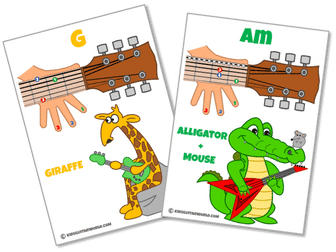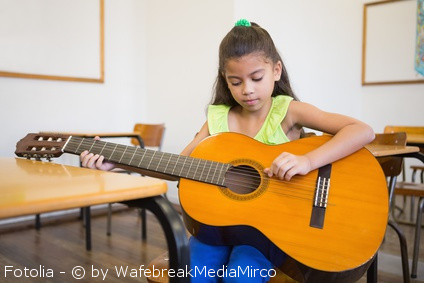
The younger kids are, the smaller their hands and arms are. Young kids won’t even be able to reach the end of the neck of a full-size guitar. They can’t even wrap their fingers around the neck to make play a guitar chord. That’s why there are different sizes of guitars on the market, especially for kids.. To avoid frustration in the beginning, you should choose the right size guitar for your child. Not only the size of the body, but also the neck is much smaller on kid’s guitars. In this article we show you how to find the right guitar size and which models we would recommend for children.
How guitars are measured
Small body guitars are either measured based on the overall length (e.g. 30″ guitar) or on the scale (1/4 guitar). The scale is the distance between the nut and the bridge, and so the part of the strings that vibrate when you pluck them (see image below).
Small body guitars are measured either by overall length (e.g. 30 inch guitar) or by scale (1/4 guitar). The scale is the distance from the nut to the bridge, which is the part of the string that vibrates when you pluck it (see picture below).
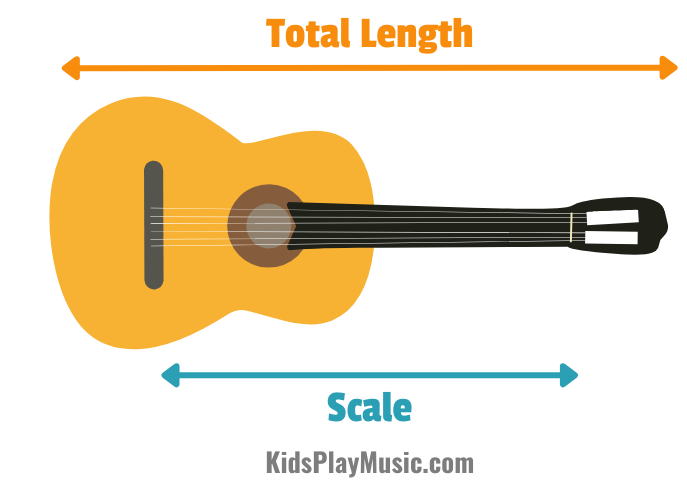
Measuring the overall length sounds simple and logical to determine the right size. In fact, a guitar that is shorter overall doesn’t necessarily have a shorter neck, sometimes it just has a smaller body (like a travel guitar, where the body size is extremely reduced while the neck remains the same size as a full size guitar). When it comes to children’s guitars, overall length isn’t the best indicator. A child needs a guitar with a shorter neck, depending on their age and height. The best way to determine the right size guitar for a child is to look at the scale. A shorter scale will always result in a shorter neck. For example, a 1/4 size guitar means that the guitar measures a quarter of the scale of a full size guitar. There are basically 4 main guitar sizes.
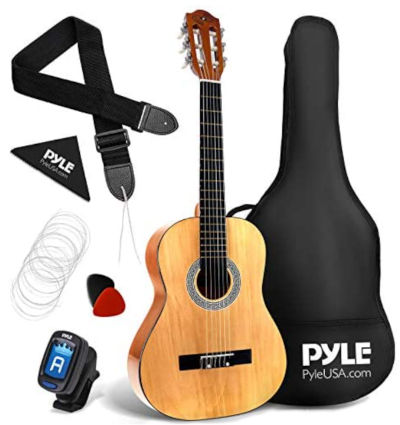
– quality is alright
– very good value for money
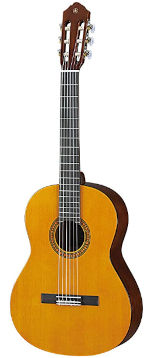
– good quality and sound
– good value for money
Pick the right guitar size for your child
When choosing a guitar for kids there are two aspects to consider: age and height. The following chart below will help you to choose easily the right guitar for your child:
| Guitar Size | Overall Length | Age | Child’s Height |
|---|---|---|---|
| 1/4 | ~ 30″ | 4-6 years | ~ 3’9″ |
| 1/2 | ~ 34″ | 6-8 years | ~ 4’3″ |
| 3/4 | ~ 36″ | 8-11 years | ~ 4’8″ |
| 4/4 | ~ 40″ | from 11 years | from 5’3″ |
Normally, all kid’s guitars sold are either 1/4, 1/2, 3/4 or full size guitars. Meanwhile, some guitar manufacturers even offer 1/8 size guitars or 7/8 size guitars. The table is just a guide and a first reference. For example, if your child is 5 years old and about 4.3″ tall, a half size guitar would be the right choice. However, if your child has larger hands, do not hesitate to go with the larger size.
The same goes if your child is close to the next size up. Get the guitar that is slightly larger. Why buy a smaller guitar if you’re going to have to get a bigger one in a few months anyway? A guitar that is theoretically only half an inch too big will not cause any problems.
By the way, 7/8 guitars are often chosen by women with small hands because they simply fit better in their hands. Some people pick up a 7/8 guitar for kids, but I think you should go for a full size guitar in that case. The difference is not that big, and since kids grow pretty fast at this age, it may only take a few months for the guitar to fit perfectly.
What when kids outgrow their guitar?
When your child outgrows the guitar, it’s not really necessary to get the next size guitar right away. It’s a fact that a guitar that’s too big will hinder a child’s ability to learn to play the guitar or have fun with it. However, a guitar that is a little too small is generally not a big problem as long as your child is comfortable with it. The best example is the ukulele. They are quite small, but adults play them without any problems.
However, it’s unlikely that your child will want to play a 1/4-size guitar when he or she is 10 years old. The larger the body, the brighter and fuller the sound. So in terms of guitar sound, it makes sense to make the move to a larger, appropriately sized guitar at some point. A good time to take this step is sometimes when kids want to switch to a different type of guitar. Many start with a classical nylon-string guitar, but often they want to switch to a dreadnought or electric guitar*
Good Kid’s Guitars indicates size related to scale
Guitar size is always listed in the product description. Some guitar manufacturers list the overall length, others list the scale length. A good guitar store or manufacturer will always refer to the scale length when it comes to kid’s guitars. Unfortunately, there are also kid’s guitars that only list the overall length in the product description.
You’ll mostly find classical nylon string guitars in children’s sizes. There are acoustic steel string and electric guitars in kid’s sizes, but I would recommend getting a classical kid’s guitar since nylon strings hurt the fingers less. Electric guitars may also be a good choice because they have quite thin strings and low tension, which means the strings are easier to press down. To help you choose the right size guitar for your child, check out our overview of guitar types.
Not often considered, but definitely worth a thought. The guitalele is a small guitar with a ukulele sound. Because of its compact size, the guitalele can be a good choice for kids in some cases.
Attention: Do not confuse children’s guitars with other types of small guitars, such as the parlor guitar or any travel guitars. The body is also reduced, but the neck length is adjusted for adult hands.


